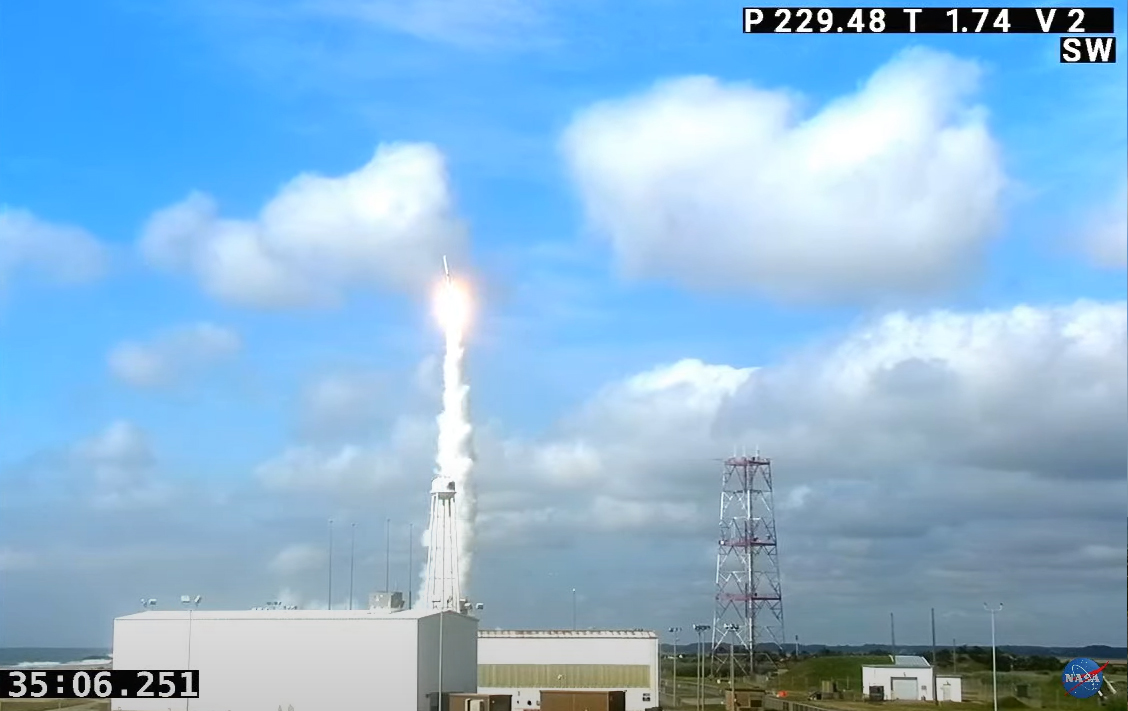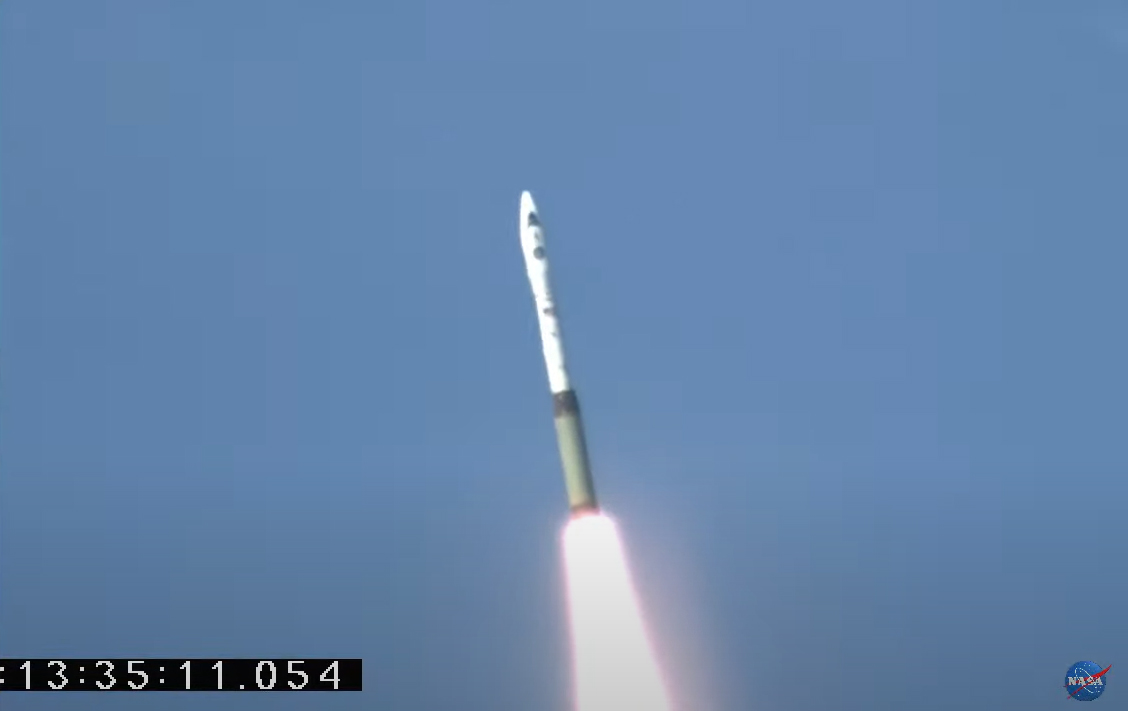Minotaur 1 rocket launches 3 classified spy satellites for National Reconnaissance Office
A Minotaur 1 rocket blasted off from the Eastern Shore of Virginia Tuesday morning (June 15), heading to orbit with three secret spacecraft for the U.S. government's spy satellite agency.
Powered by a repurposed missile stage that dates back to the 1960s, the solid-fueled launcher blasted off from Pad 0B at the Mid-Atlantic Regional Spaceport (MARS) located at NASA's Wallops Flight Facility on Wallops Island, Virginia at 9:35 a.m. EDT (1335 GMT) after just more than two hours of delays due to weather.
Riding aboard the Minotaur 1 was NROL-111, a trio of classified satellites built for the U.S. National Reconnaissance Office. As is typical with NRO launches, NASA cut its live webcast of the launch just a few minutes after liftoff.
Related: Spectacular Minotaur 1 rocket night launch photos by stargazers

Today's launch of the Minotaur 1, which is assembled and operated by Northrop Grumman, marked its first mission since 2013. (The Minotaur family of rockets is primarily geared to launch satellites for the military.)
The vehicle stands at 69-foot-tall (21 meters) and like its namesake the mythological half-man, half-bull, the Minotaur I is a modified missile repurposed to launch government payloads.
According to officials at Northrop Grumman, the first stage is more than 50 years old, which means it is likely the oldest rocket motor ever used on a space launch; however, teams test-fired motors with similar ages a few years ago and verified the performance. The motors were then stored and refurbished at Hill Air Force Base in Utah, before shipping out for launch preparations.
Get the Space.com Newsletter
Breaking space news, the latest updates on rocket launches, skywatching events and more!
"We are using these decommissioned assets, taxpayer-funded assets, and we're taking them and we're able to launch government-sponsored payloads, which to me is actually one of the coolest things about our Minotaur 1 rocket," Kelly Fitzpatrick, a Northrop Grumman senior guidance, navigation and control engineer told Space.com in an interview Friday (June 11).
Gallery: Declassified US Spy Satellite Photos & Designs
A secret mission

The NROL-111 mission involves three classified satellites launching for the U.S. National Reconnaissance Office (NRO), the agency that oversees the country's fleet of spy satellites. While the satellites on the Minotaur 1 rocket are classified, NRO officials held a prelaunch press teleconference Thursday (June 10) to preview the mission.
"We certainly cannot get into any specifics for national security reasons, but I can tell you that there are three spacecraft that will be launched on this mission," Col. Chad Davis, director of the NRO's office of space launch, said during the press conference. "NRO payloads and capabilities, in general, are the nation's eyes and ears in space, being able to deliver that exquisite intelligence information from space that our warfighters and national decision-makers need."
The fleet of top-secret satellites collect high-resolution optical and radar imagery of various sites around the world, eavesdrop on communications from U.S. adversaries and help track worldwide military activity.
The mission's contract, awarded to Orbital ATK (now Northrop Grumman) in 2016, is valued at $29.2 million. The Space Force's Space and Missile Systems Center, then part of the Air Force, selected the Minotaur 1 rocket for the NROL-111 mission.
The launch marks the 28th flight of a Minotaur rocket since 2000, and the 12th of this specific configuration which is capable of lifting payloads up to 1,278 lbs. (580 kilograms).
Today's flight was the eighth Minotaur rocket to launch from the MARS facility at Wallops in Virginia and the second in just 12 months. Minotaur missions have the capability of launching from multiple launch sites including Cape Canaveral in Florida, Vandenberg Space Force Base in California and Alaska's Pacific Spaceport.
The rocket was the second orbital launch to blast off from MARS so far this year, following another Northrop Grumman flight in February. On that mission for NASA, an Antares rocket carried a Cygnus cargo craft full of research experiments and supplies for the astronaut crew on board the International Space Station.
Tuesday's NROL-111 mission is also the second launch in three days for Northrop Grumman's rocket program.

The company's air-launched Pegasus XL rocket soared into orbit on Sunday (June 13) off the coast of California carrying a small satellite named Odyssey for the U.S. Space Force. The spacecraft was rapidly developed, rolling off the assembly line in less than 12 months, as part of an effort to demonstrate a "tactically responsive launch" capability.
"It just shows the depth and breadth of Northrop Grumman's capabilities that we have fairly independent teams to be able to get these two launches off in two days on opposite coasts," said Kurt Eberly, head of the company's launch vehicles division.
Military officials provided the target launch date for Odyssey to Northrop Grumman just 21 days ahead of time. The company modified a Pegasus rocket already in its inventory fit the Space Force's needs and launch the space surveillance satellite.
Today's launch kicks off a busy summer for Wallops as the Virginia-based facility has several launches on the schedule, including another Antares resupply mission to the space station. That flight, dubbed NG-16, is scheduled to blast off in August.
Follow Amy Thompson on Twitter @astrogingersnap. Follow us on Twitter @Spacedotcom or Facebook.
Join our Space Forums to keep talking space on the latest missions, night sky and more! And if you have a news tip, correction or comment, let us know at: community@space.com.

Amy Thompson is a Florida-based space and science journalist, who joined Space.com as a contributing writer in 2015. She's passionate about all things space and is a huge science and science-fiction geek. Star Wars is her favorite fandom, with that sassy little droid, R2D2 being her favorite. She studied science at the University of Florida, earning a degree in microbiology. Her work has also been published in Newsweek, VICE, Smithsonian, and many more. Now she chases rockets, writing about launches, commercial space, space station science, and everything in between.
